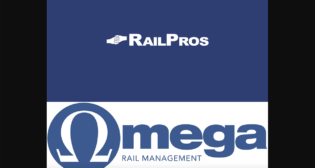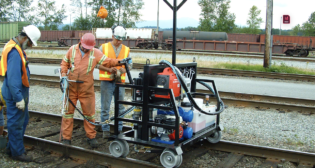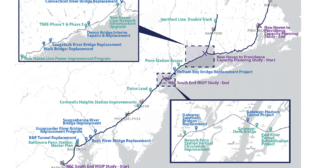
Saving time and money
Written by William C. Vantuono, Editor-in-ChiefMaintenance on the railroad can be caught in a revolving cycle where increased traffic requires additional maintenance. However, the increased traffic results in tight work windows. Suppliers offer solutions to help break this cycle by addressing a simple question: “How can this be done better?” Their answers follow.
The Drone
Harsco Rail says it designs solutions to save railways time and money. From mechanizing labor-intensive processes, to precise control systems, the company continues to help customers improve their track maintenance and construction operations and points to its Drone Tamper as its best example of an improvement in maintenance equipment.
The Drone can couple with existing surfacing equipment and increases efficiency and productivity with its ability to operate in a skip-tie formation. Its remote control operation improves safety by removing workers from the equipment. Harsco says it is working on the next generation of this machine, as well as a generation of more Drone equipment.
 “We are working on more than 30 new product development projects and each of them addresses the key drivers that impact time and money. We are investigating new methods to improve fuel savings, increase productivity, reduce downtime, more effectively use labor, and increase safety,” says Evan Sevel, Harsco Rail director of equipment.
“We are working on more than 30 new product development projects and each of them addresses the key drivers that impact time and money. We are investigating new methods to improve fuel savings, increase productivity, reduce downtime, more effectively use labor, and increase safety,” says Evan Sevel, Harsco Rail director of equipment.
Harsco Rail is committed to investing in new technology and incorporating it into machine design, as well as equipment upgrades. While many of these developments remain confidential and/or pending patent approval, one new product launched this year was the Bullet Projector for Mark Series Tampers. “With Harsco Rail’s dedication to product development and improvement, railways and contractors will continue to benefit from Harsco’s new technology and equipment that will equal or surpass the success of past projects, such as the Jupiter Control System, Drone Tamper, Bullet Projector, Double Barrel Receiver, and Smart Grind Software,” Sevel says.
Rail unloading process
Herzog Railroad Services, Inc. (HRSI) looks to improve productivity with its equipment, but says the real goal is increased safety. One area the company saw room for improvement was the rail unloading process. Its Rail Unloading Machine (RUM) and Automated Tie Down Car can function as a combo or independently. According to Tim Francis, vice president of marketing, both result in safety and efficiency gains, as well as better manpower utilization.
The idea behind the RUM was to make the rail unloading process safer and more efficient. The company achieved this by eliminating the need for manual intervention during rail unloading. Instead of requiring personnel be on the ground in between sticks for rail or to tie off the first stick of rail, the RUM utilizes a knuckle boom crane to pull the rail into the power box, which then feeds the rail through the machine and unloads it at the same speed that the train is traveling.
Francis says the RUM is capable of unloading single or double sided and averages 10 sticks of rail an hour.
“The RUM can move from job site to job site on the highway with a crew of two, eliminating the need for costly and time consuming switching of maintenance-of-way equipment,” says Francis. “At the completion of the project, the RUM cuts away from the rail train and exits from the track. Within a few minutes, the RUM can be ready for highway travel to the next assignment.”
Francis says that after the RUM was developed, the next logical step was to develop a tie down car that increases personnel safety.
“We approached the process from a safety standpoint and asked what could we do to make the process safer. So, we took the manual tie down car and automated it,” says Francis.
The Automated Tie Down Car is operational via remote control from up to a quarter-mile away and can also be operated from the RUM. Francis says that in addition to safety, there is significant time savings as it pertains to unclamping and clamping the rails. He says a process that can take more than seven minutes to perform manually, takes seconds with the Automated Tie Down Car.
“The automation of the tie down car supports the railroads’ desire to reduce track and time needs and increase the window of time to run revenue freight,” says Francis.
The Raptor
Scott Diercks, product development manager at Loram Maintenance of Way Inc., points to the way railroads handle rail as an area where savings can be seen in both time and money and productivity can be gained. He notes that progressive rail replacement programs are putting demands that the existing fleet of aging CWR trains across North America can’t meet in a safe, efficient manner. Additionally, he says the introduction of rail gantry loading systems allowed an opportunity for equipment manufactures to revolutionize the practice of handling rail, but the units lack the power required to load long strings of rail and lack an ergonomic, safe operating platform that retains total control of the rail during the joining process.
“Loram’s Raptor Rail Handling System addresses all the shortcomings of early gantry units,” says Diercks. “It consists of a rail pick-up and delivery system for both new and second hand rail. Our design provides a next generation solution embedded with superior features and unmatched operational efficiencies.
“The life-cycle of rail includes four logistical components: 1) transport from steel mill or ship to welding plant, 2) delivery of CWR from plant to trackside, 3) pick-up of relay rail for reuse or re-welding, and 4) pick-up and disposition of scrap rail. Our system is a family of machines that can provide service in any of these four areas. While the initial focus is on rail pick-up, the machine can also deliver rail efficiently. Its design also anticipates expected increased in rail sizes, overall length, and top-load abilities.”
Diercks mentions the Raptor’s strengths lie in its lower manpower requirements and improvements in safety vs. existing units.
“We have shown it will deliver productivity improvement of 50% or more in everyday service (3,000 to 5,000 feet per hour). The increase allows our customers to reduce their fleet size and capital requirements. Additional selling points include improved rail quality, or ‘relay ready’ rail, by eliminating torch cutting of ends and bolt-holes, and a flexible, durable CWR train design,” says Diercks.
Loram believes the ability to top load its trains will prove critical as rail rolling and welding processes evolve.
“Rail rolling technology and practices are changing. Mills are already rolling 100-meter rail, with a goal of 150-meter strings. Only Loram’s CWR trains can be top loaded with these rails, and with a welding unit mounted on the Raptor, we can deliver strings of CWR of any length,” says Diercks.
While the company aims to increase productivity, it keeps a focus on safety. Diercks says Loram’s equipment retains total control of the rail during loading and unloading, diminishing the risk of injury because human interaction with the rail is reduced.
“The equipment also provides a very stable and ergonomic workstation that locks the rail in place mechanically when there is a need for an operator to come in to physical contact with the rail. Future enhancements include an automated rail joining station that can further improve safety, reduce manpower needs, and increase productivity even further,” says Diercks. “Other future modules include improved scrapping abilities that will allow railways to capitalize on additional returns, rather than allowing third parties to exploit disposition revenues.”
Maximizing work windows
Plasser American Corp. recognizes the two-part challenge presented by increased traffic: Additional maintenance is required because of it, but it also further constrains track time, which is already at a premium.
The company has worked to help alleviate this in multiple ways and offers an example in the various versions of the 09 Series CAT (Continuous Action Tamper), celebrating its 30th anniversary, which is capable of much higher production rates than conventional indexing tampers. The machines are available in models that are capable of tamping one, two, three, and four ties at a time. Plasser says that this capability, combined with continuous tamping methodology means the 09 Series tamper can achieve production rates of up to and exceeding one mph; what used to be a full day’s work can be accomplished in one hour or less.
Plasser also mentions the combination of the 09 Series tamper with a track stabilizer into a single machine, such as the DynaCAT (pictured at left) and 09-3X Dynamic Tamper (top photo), as a way of combining work processes to increase productivity without straining resources. The company says the use of a dynamic track stabilizer helps restore the track to maximum speed following maintenance, resulting in less hindrance of train traffic.
Another challenge Plasser has addressed is longer lasting track quality, which means a reduction in maintenance intervals. Plasser points to its use of its non-synchronous uniform hydraulic squeeze tamping units as a way to insure uniform ballast compaction under each tie. The tamping units operate at 35 Hz, which Plasser says has been proven to provide the maximum consolidation of the ballast under the tie while also allowing easy penetration of the tamping tools into the ballast.
“A way of providing additional safety is Plasser’s MDZ system, which allows machines to be coupled together for track traveling to and from the worksites, eliminating the possibility of machine collisions,” says Plasser.
Rail life management
Vossloh Rail Services is developing high speed rail milling, a newer, proven, rail life management technology not presently used in North America.
“The benefits of milling have been proven in numerous markets around the world and Vossloh is now looking to bring it to North America,” says Ron Martin, vice president and general manager of Vossloh Rail Systems. “The quality and overall finished product of the rail after milling helps lengthen rail life and reduce maintenance costs. With the system not producing any sparks, scheduling is much easier as it can work anywhere and anytime regardless of extenuating fire hazards.
“The system also allows the maintenance of rail on bridge decks, in tunnels and in areas where traditional grinding may be restricted. With the system being virtually noise free, the technology can also be used in highly populated areas without upsetting anyone. This technology is the cleanest and quietest method of rail management available.”
Martin says the milling technology being developed will operate faster than existing systems, have a cleaner finished product, and will remove more metal per pass to help keep production up and costs down.
Vossloh’s high performance milling will focus on quality, flexibility, and speed. Martin notes that in comparison to the market-standard milling technology, the new milling trains will be able to work at speeds up to four mph, which means almost double the present speed. Additionally, Vossloh’s milling technology will be able to re-profile rail in one pass with removal rates of up to 3 mm on the running surface and 10 mm at the gauge corner.
The offerings by Vossloh Rail Services will include program management software and eddy current pre-testing to identify deficient areas and what removal rate is required. The actual milling itself and the post-milling validation will also include eddy current testing to ensure the rail is free from all defects, including those that are not detectable to 3mm.
“This puts the rail back in new-rail condition. This system, in conjunction with high speed grinding systems in use now, have proven to increase the time between rail exchanges, reduce the cost of maintenance, and reduce potential rail defect incidents,” says Martin.



